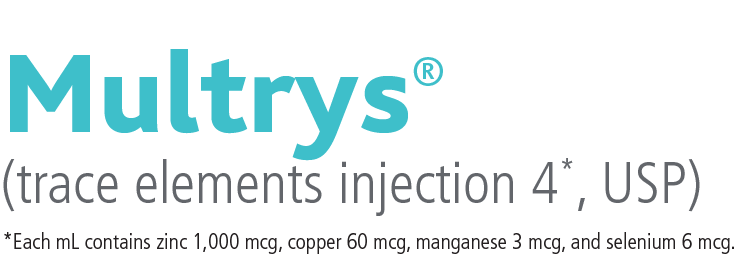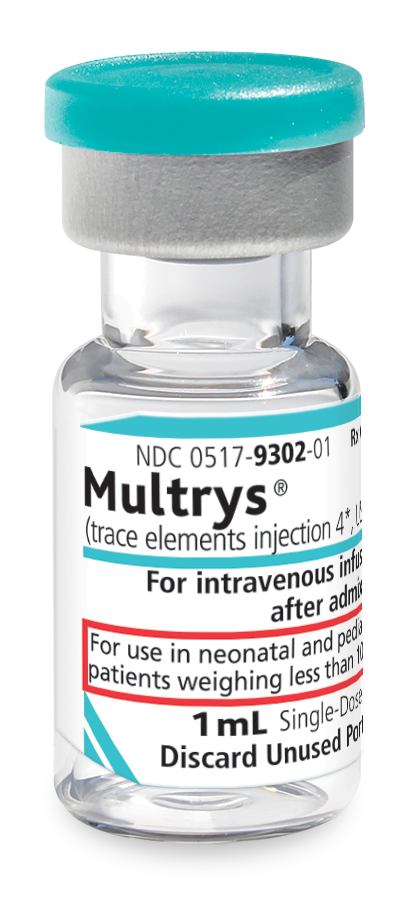Contact Us
By clicking Submit, you confirm that you accept our Privacy Policy and that you agree to your personal contact information being used to contact you and added to our database. If at any time you wish your personal information to be removed from the American Regent® database, please submit a message request to corpcommunications@americanregent.com.
CONTRAINDICATIONS
Contraindicated in patients with hypersensitivity to zinc or copper.
WARNINGS AND PRECAUTIONS
Pulmonary Embolism due to Pulmonary Vascular Precipitates: Pulmonary vascular precipitates causing pulmonary vascular emboli and pulmonary distress have been reported in patients receiving parenteral nutrition. If signs of pulmonary distress occur, stop the parenteral nutrition infusion and initiate a medical evaluation.
Vein Damage and Thrombosis: Multrys must be prepared and used as an admixture in parenteral nutrition solution. It is not for direct intravenous infusion. In addition, consider the osmolarity of the final parenteral nutrition solution in determining peripheral versus central administration. Solution with an osmolarity of 900 mOsmol/L or greater must be infused through a central catheter. The infusion of hypertonic nutrient solution into a peripheral vein may result in vein irritation, vein damage, and/or thrombosis.
Neurologic Toxicity with Manganese: Monitor for clinical signs and symptoms of neurotoxicity, whole blood manganese concentrations, and liver function tests. Discontinue Multrys and consider brain magnetic resonance imaging (MRI) if toxicity is suspected. Monitor patients for cholestasis or other biliary liver disease.
Hepatic Accumulation of Copper and Manganese: If a patient develops signs or symptoms of hepatobiliary disease during the use of Multrys, obtain serum concentrations of copper and ceruloplasmin as well as manganese whole blood concentrations; consider using individual trace element products in these patients.
Aluminum Toxicity: Multrys contains aluminum that may be toxic. Patients with renal impairment and preterm infants, including preterm neonates, are particularly at risk.
Monitoring and Laboratory Tests: Monitor blood zinc, copper, and selenium serum concentrations, whole blood manganese concentration, fluid and electrolyte status, serum osmolarity, blood glucose, liver and kidney function, blood count, and coagulation parameters.
Hypersensitivity Reactions with Zinc and Copper: If hypersensitivity reactions occur, discontinue and initiate appropriate medical treatment.
ADVERSE REACTIONS
The following adverse reactions were identified in clinical studies or post-marketing reports. Given that some of these reactions were reported voluntarily from a population of uncertain size, it is not always possible to reliably estimate their frequency or establish a causal relationship to drug exposure.
Adverse reactions with other components of parenteral nutrition solutions:
- Pulmonary embolism due to pulmonary vascular precipitates
- Vein damage and thrombosis
- Aluminum toxicity
Adverse reactions with the use of trace elements administered parenterally or by other routes of administration:
- Neurologic toxicity with manganese
- Hepatic accumulation of copper and manganese
- Hypersensitivity reactions with zinc and copper
USE IN SPECIFIC POPULATIONS
Hepatic Impairment - Hepatic accumulation of copper and manganese have been reported with long-term administration in parenteral nutrition. For patients with cholestasis, biliary dysfunction, or cirrhosis, monitor hepatic and biliary function during long-term administration of Multrys.
OVERDOSAGE
There are reports on overdosage in the literature for the individual trace elements. Management of overdosage is supportive care based on presenting signs and symptoms.
INDICATIONS AND USAGE
Multrys is a combination of trace elements (zinc sulfate, cupric sulfate, manganese sulfate, and selenious acid) indicated in neonatal and pediatric patients weighing less than 10 kg as a source of zinc, copper, manganese, and selenium for parenteral nutrition when oral or enteral nutrition is not possible, insufficient, or contraindicated.
For additional safety information, please see Full Prescribing Information.
You are encouraged to report Adverse Drug Events to American Regent Inc. at 1-800-734-9236, or to the FDA by visiting www.fda.gov/medwatch or by calling 1-800-FDA-1088.
REF-1826 7/2024

